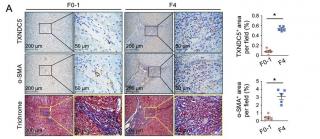Sep, 2022

Liver fibrosis (LF) occurs following chronic liver injuries. Currently, there is no effective therapy for LF. Recently, we identified thioredoxin domain containing 5 (TXNDC5), an ER protein disulfide isomerase (PDI), as a critical mediator of cardiac and lung fibrosis. We aimed to determine if TXNDC5 also contributes to LF and its potential as a therapeutic target for LF. Histological and transcriptome analyses on human cirrhotic livers were performed. Col1a1-GFPTg , Alb-Cre;Rosa26-tdTomato and Tie2-Cre/ERT2;Rosa26-tdTomato mice were used to determine the cell type(s) where TXNDC5 was induced following liver injury. In vitro investigations were conducted in human hepatic stellate cells (HSCs). Col1a2-Cre/ERT2;Txndc5fl/fl (Txndc5cKO ) and Alb-Cre;Txndc5fl/fl (Txndc5Hep-cKO ) mice were generated to delete TXNDC5 in HSCs and hepatocytes, respectively. Carbon tetrachloride treatment and bile duct ligation surgery were employed to induce liver injury/fibrosis in mice. The extent of LF was quantified using histological, imaging and biochemical analyses. TXNDC5 was upregulated markedly in human and mouse fibrotic livers, particularly in activated HSC at the fibrotic foci. TXNDC5 was induced by transforming growth factor β1 (TGFβ1) in HSCs and it was both required and sufficient for the activation, proliferation, survival and extracellular matrix production of HSC. Mechanistically, TGFβ1 induces TXNDC5 expression through increased ER stress and ATF6-mediated transcriptional regulation. In addition, TXNDC5 promotes LF by redox-dependent JNK and signal transducer and activator of transcription 3 activation in HSCs through its PDI activity, activating HSCs and making them resistant to apoptosis. HSC-specific deletion of Txndc5 reverted established LF in mice. ER protein TXNDC5 promotes LF through redox-dependent HSC activation, proliferation and excessive extracellular matrix production. Targeting TXNDC5, therefore, could be a potential novel therapeutic strategy to ameliorate LF.